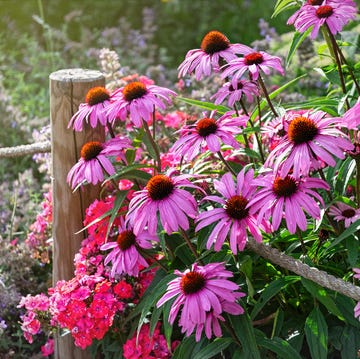1Red Columbines
 SusanGaryPhotography//Getty Images
SusanGaryPhotography//Getty ImagesThis pretty perennial wildflower blooms in the spring, providing early nectar for pollinators like hummingbirds. Avoid overwatering these blooms and mulch them before the ground freezes to protect their roots.
Sun Exposure: light shade to full sun
USDA Hardiness Zones: 2 to 9
SHOP NOW
2Daylilies
 Ji-fang Zhang//Getty Images
Ji-fang Zhang//Getty ImagesThey're a favorite of hummingbirds, and they'll be a favorite of yours once you learn how low-maintenance they really are! Daylilies can survive almost anything, including drought, uneven sunlight, and poor soil.
Sun Exposure: full sun
USDA Hardiness Zones: 4 to 9
SHOP NOW
Advertisement - Continue Reading Below
3Lupines
 Motionshooter//Getty Images
Motionshooter//Getty ImagesLupines, also known as bluebonnets, are known for their colorful spikes of tubular flowers that attract all types of pollinators, including hummingbirds. These perennials thrive in moist, sandy, well-drained soil and cool temperatures.
Sun Exposure: full sun
USDA Hardiness Zones: 4 to 8
SHOP NOW
4Foxgloves
 crbellette//Getty Images
crbellette//Getty ImagesHummingbirds and bumblebees alike love this pretty spiked flower with bell-shape blossoms! These biennials grow best in full sun and moist, well-drained soil.
Sun Exposure: light shade to full sun
USDA Hardiness Zones: 4 to 8
SHOP NOW
Advertisement - Continue Reading Below
5Hollyhocks
 Saddako//Getty Images
Saddako//Getty ImagesThese pretty flowers can grow up to eight feet tall, where their brightly colored blooms attract plenty of butterflies and hummingbirds. Hollyhocks prefer full sun and evenly moist soil.
Sun Exposure: part shade to full sun
USDA Hardiness Zones: 3 to 9
SHOP NOW
6Fuchsia
 Getty Images
Getty ImagesFuchsia, also called hardy fuchsia or hummingbird fuchsia, is a striking annual with exotic-looking flowers in shades of white, pink, hot pink and purple. Hummingbirds adore this plant!
Sun Exposure: part shade
USDA Hardiness Zones: 6 to 9
SHOP NOW
Advertisement - Continue Reading Below
7Salvia
 Getty Images
Getty ImagesTube-shaped flowers of pink, purple or two-tones are a favorite of hummingbirds. There are both annual and perennial types, but they both need a lot of sun.
Sun Exposure: part shade to full sun
USDA Hardiness Zones: 9 to 11
SHOP NOW
8Bee Balm
 Getty Images
Getty ImagesThis native plant comes in bright, saturated colors such as red and pink. Pollinators of all types enjoy visiting this perennial with its cute fringed flowers. Look for newer varieties that won’t take over your garden beds.
Sun Exposure: part sun to full sun
USDA Hardiness Zones: 4 to 8
SHOP NOW
Advertisement - Continue Reading Below
9Penstemon
 Getty Images
Getty ImagesThis striking perennial has tall spikes with many tubular flowers, which hummingbirds prefer. The foliage may be green or burgundy, so it's a handsome plant even when not in bloom.
Sun Exposure: full sun
USDA Hardiness Zones: 3 to 8
SHOP NOW
10Hummingbird Mint
 Getty Images
Getty ImagesThis pretty perennial, also called agastache, has spikes of purple, deep or pale orange flowers that bloom all summer long. It’s not fussy about soils and is drought tolerant once established.
Sun Exposure: full sun
USDA Hardiness Zones: 5 to 10
SHOP NOW
Advertisement - Continue Reading Below
11Phlox
 Robin Wilson Photography
Robin Wilson PhotographyThis tall perennial comes in many different shades of pink, white and purple. It's an old-fashioned favorite that's fragrant and reliable year after year. New varieties are more resistant to powdery mildew.
Sun Exposure: part sun to full sun
USDA Hardiness Zones: 3 to 8
SHOP NOW
12Catmint
 Rolf Nussbaumer//Getty Images
Rolf Nussbaumer//Getty ImagesWith silvery foliage that has a pleasant minty-spicy scent and spikes of purple flowers, this hardy perennial is a pollinator favorite that tolerates poor soils. Hummingbirds especially love catmint.
Sun Exposure: full sun
USDA Hardiness Zones: 3 to 8
SHOP NOW
Advertisement - Continue Reading Below
13Wishbone Flower
 Danita Delimont//Getty Images
Danita Delimont//Getty ImagesThe delicate pink, white or purple flowers with white throats beckon hummingbirds. This annual, also called torenia, blooms all summer long until a hard frost and is especially striking in window boxes so it can cascade.
Sun Exposure: part sun to full sun
USDA Hardiness Zones: 10 to 11
SHOP NOW
14Sunflower
 Larry Keller, Lititz Pa.//Getty Images
Larry Keller, Lititz Pa.//Getty ImagesThis annual is a hit with all kinds of pollinators, especially bees. But hummingbirds also enjoy visiting the many different types of sunflowers for late-season nectar.
Sun Exposure: full sun
USDA Hardiness Zones: 2 to 11
SHOP NOW
Advertisement - Continue Reading Below
15Butterfly Bush
 Getty Images
Getty ImagesJust like other pollinators, hummingbirds enjoy visiting the spikes of white, pink or purple flowers on this shrub which blooms from spring to frost. Newer types are more compact so they fit in small gardens, and they're also not invasive.
Sun Exposure: full sun
USDA Hardiness Zones: 5 to 9
SHOP NOW
16Calibrachoa
 DansPhotoArt on flickr//Getty Images
DansPhotoArt on flickr//Getty ImagesSimilar to petunias in appearance, this annual has oodles of flowers that bloom from planting to a hard frost. They’re especially appealing to hummingbirds when cascading from window boxes and hanging baskets.
Sun Exposure: part shade to full sun
USDA Hardiness Zones: 9 to 11
SHOP NOW
Advertisement - Continue Reading Below
17Bleeding Heart
 Getty Images
Getty ImagesThis is an old-fashioned favorite that should be in every garden! It's easy to see how the unusual flowers, which provide early season nectar to hummingbirds, got their name.
Sun Exposure: full shade to part sun
USDA Hardiness Zones: 3 to 9
SHOP NOW

Arricca Elin SanSone is a writer, editor, and content creator who specializes in lifestyle and gardening. With a background in health reporting, she applies these same research skills when writing about the science of growing things. She trials new plants in her expansive garden, and her houseplant collection consists of 60+ varieties. Arricca has written thousands of articles for publications such as Country Living, House Beautiful, Good Housekeeping, Prevention, VERANDA, Southern Living, and more. She’s happiest when digging in the dirt, baking, or spending time with the people and dogs she loves.
Advertisement - Continue Reading Below
Advertisement - Continue Reading Below
Advertisement - Continue Reading Below






























